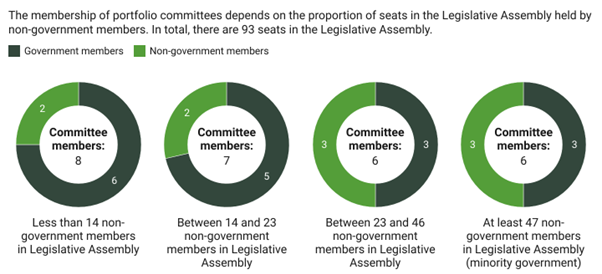-
Work of committees
- Upcoming Committee Business
- About Committees
- Training Seminar - Committees@Work
- Committees (13)
- Committees Glossary
- Estimates Hearings
- Inquiries
- Live and Archived Broadcasts
- Publications
- Guidelines (4)
- Subscribe
- Former Committees (57)
- 30 Year Release
- Past Alert Digest and Legislation Alert Indexes
- Ten Year Anniversary
Membership and operation of portfolio committees
Queensland’s current committee system was established in 2011.
Under that system, most parliamentary committees are established by legislation. This includes the portfolio committees, which are responsible for particular areas such as health and the environment. Queensland’s constitution requires the Parliament to have at least six portfolio committees that collectively cover all areas of government activity. At present, there are seven portfolio committees.
The Parliament of Queensland Act 2001 governs the membership and operation of portfolio committees. The size and composition of the portfolio committees must reflect the political makeup of the Legislative Assembly at the time.
Figure 1: Membership of portfolio committees reflects the Legislative Assembly
Source: Sections 91, 91A, 91B and 91C of the Parliament of Queensland Act 2001. Figure created using Datawrapper.
At present, there are 41 non-government members in the Legislative Assembly, so portfolio committees have six members: three government members, and three non-government members.
The chairperson of each portfolio committee plays an important role. When governments have a majority in the Legislative Assembly but not in the portfolio committees, as is the case at present, the chairperson has a casting vote. This means they are able to determine the outcome if an equal number of members vote for and against a proposed decision.
When governments have a majority in the Legislative Assembly, the Leader of the House nominates each committee’s chairperson, who will typically be a government member. If there is a minority government, the Legislative Assembly would nominate the chairperson.
Committee members receive an additional payment on top of the base salary for all members of parliament in recognition of the importance of their committee work.

